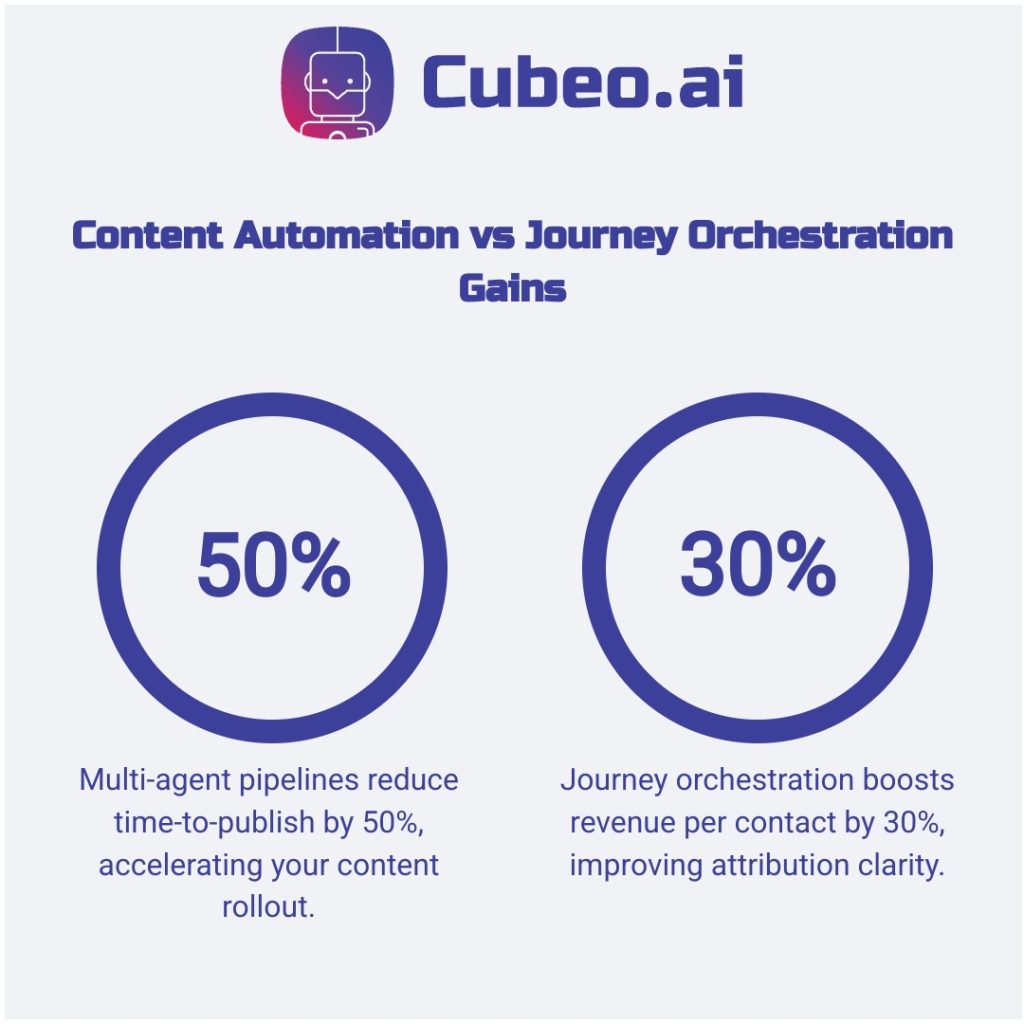Your team likely loses weeks each quarter to manual research, repetitive personalization, and content handoffs. Pick one AI marketing agent workflow, run a 30-day pilot, and measure one KPI — CTR, lead velocity, or time-to-publish — to decide whether to scale.
AI marketing agents are specialist assistants that handle specific tasks. Think of multi-agent orchestration like a project team: a Researcher Agent finds prospects, a Content Agent writes copy, and an Orchestrator Agent hands work between them when triggers fire (events like “new lead submitted” or “draft approved”).
AI-driven personalization increases customer spending by 38% when experiences match preferences. Marketing teams using agent workflows report similar conversion and efficiency improvements in pilot programs.
This guide maps 10 concrete AI use cases across research, content creation, and media optimization. Each workflow pairs specific Cubeo Agents with event-driven triggers and tracks one measurable KPI you can test within 30 days.
You’ll discover practical agent combinations for lead scoring, content repurposing, and campaign optimization that you can pilot in 30 days without coding. Every use case includes Agent + Trigger setup, the KPI to track, and one-line measurement guidance.
Research and Targeting That Converts
Smart targeting starts with better data, not bigger budgets. AI agents transform how you capture behavioral signals, monitor competitors, and research content opportunities by automating workflows that typically consume hours of manual work.
Audience Signal Capture and Dynamic Personas
Your CRM stores contacts, but much of the buying signal is missing. 67% of businesses waste marketing budget on poor-quality leads (MarketsandMarkets, 2025). Use a Signal Enrichment Agent to monitor new leads, form fills, and behavior and add firmographics (company size/industry), technographics (tech stack), and intent signals automatically.
Trigger: New lead created OR contact property updated
KPI: Enriched leads convert 2× faster; audience match +20–30% (early pilots)
How to measure: Compare ICP fit score (Ideal Customer Profile) and time-to-qualified-lead over a 30-day pilot
Competitive Intelligence Monitoring
Run a Competitor Watch Agent to crawl competitor sites, press releases, and review platforms on a weekly schedule so you surface positioning changes without manual hunting.
Trigger: Weekly cron schedule OR keyword alert (competitor launches new feature)
KPI: Research time −50% vs manual; find positioning gaps weeks earlier (AlphaSense, 2025)
How to measure: Count actionable insights surfaced per week and measure time saved vs your manual baseline
Contextual Content Research With RAG
Use a RAG Research Agent (Retrieval-Augmented Generation combines your knowledge base with live web sources) to auto-generate briefs that include past campaigns, case studies, and current market context.
Trigger: Content request submitted OR campaign kickoff
KPI: Brief turnaround from hours to minutes; fewer revision cycles
How to measure: Compare brief turnaround time and first-draft approval rate across a 30- day sample
Once you’ve captured better signals and research, the next step is turning those insights into content that scales across channels.

Content and Lifecycle Automation
Content bottlenecks kill momentum. Multi-agent pipelines (multiple AI assistants working in sequence like an assembly line) eliminate these chokepoints by automating content production, personalization, and lifecycle nurture with measurable throughput improvements.
Multi-Agent Content Production Pipelines
Start a Brief Agent → Draft Agent → SEO Agent → Approval Agent chain. This moves ideas to published pieces with clear handoffs (Brief = topic + context; Draft = first-pass copy; SEO = on-page optimization; Approval = human checkpoint). Multi-agent workflows reduce time-to-publish by 40–60% and increase content output 2–3× without adding headcount (ReelMind.ai, 2025).
Trigger: Content calendar event OR campaign launch
KPI: Time-to-publish reduced 40–60%; content output increased 2–3×
How to measure: Track days from brief to publish and pieces per month before/after pipeline deployment
Dynamic Email and Landing Page Personalization
Use a Personalization Agent (reads profile + behavior and injects tailored copy) that monitors contact properties and recent actions to customize copy, CTAs, and offers automatically. Personalization delivers 20–30% conversion rate lifts in pilot programs (DigitalDefynd, 2025).
Trigger: Email send OR page view
KPI: Engagement rates improve by double digits; CVR lifts 20–30%
How to measure: A/B test personalized vs static variants; track CVR lift over 30 days
Automated Lifecycle Nurture Sequences
Run a Nurture Orchestrator (monitors stage changes and triggers next-best actions) that watches lifecycle progression and engagement signals to send targeted emails or create tasks automatically.
Trigger: Stage change OR engagement threshold (email opened 3×)
KPI: Lead-to-opportunity conversion improves by low double digits; sales handoff quality increases (DigitalDefynd, 2025)
How to measure: Compare stage progression velocity and MQL→SQL conversion rate before/after automation
Real-Time Journey Orchestration
Deploy a Journey Agent (listens across channels and adjusts messaging) that monitors cross channel events (web, email, ad clicks) and modifies offers in real time. Journey orchestration improves revenue per contact by 20–40% in optimized campaigns (DigitalDefynd, 2025).
Trigger: Any touchpoint event
KPI: Journey value (revenue per contact) improves 20–40%; attribution clarity increases
How to measure: Track revenue per journey and multi-touch attribution lift vs control cohort
With content scaling and lifecycle automation running, the final step is optimizing media spend and measuring performance across all channels.

Media Optimization and Governance
Scale demands automation. Use agents to optimize spend, boost ROAS, and enforce compliance automatically. This final layer handles paid media performance, attribution measurement, and compliance auditing with measurable improvements and risk reduction.
Real-Time Paid Media Bid and Budget Optimization
Run a Bid Optimizer Agent (monitors performance metrics and adjusts spend via API) that tracks campaign performance (CPA, ROAS) and modifies bids, budgets, and audience targeting through Google Ads, Meta, LinkedIn APIs. One case study shows 200% ROI within 2 months of deployment (Wrench.ai, 2025).
Trigger: Hourly performance check OR threshold breach (CPA > target) KPI: Expected pilot range: 15–30% ROAS improvements; manual bid management time drops significantly
How to measure: Compare ROAS and CPA before/after agent deployment; track hours saved on manual bid adjustments
Pilot: Run 4–8 week A/B test on matched campaigns and compare ROAS/CPA vs control
Attribution and AI Discovery for SEO
Deploy an Attribution Agent (shows how each channel contributes to conversion) plus an SEO Discovery Agent (optimizes for people-first signals and monitors visibility in AI answer engines like ChatGPT/Perplexity). 82% of agencies report AI meets or exceeds expectations for attribution and performance measurement (IAB, 2025).
Trigger: Daily attribution refresh OR content publish
KPI: Attribution clarity improves journey understanding by 30–50%; AI citations increase 20–30%
How to measure: Track multi-touch attribution accuracy and AI citation frequency vs baseline; monitor organic traffic from AI search tools
Pilot: Test 30-day attribution model vs current setup; track AI citations for 20+ published pieces
Automated Brand and Compliance Governance
Use a Governance Agent (scans content for violations and compliance risks) that audits all outbound content for brand guideline violations, compliance risks (GDPR, CAN-SPAM), and tone consistency. Build custom governance workflows with production safeguards: human approval for high-risk flags, immutable logs for audits, versioned policy rules, and rollback/pause controls.
Trigger: Content submitted for approval OR scheduled publish
KPI: Automated governance can push audit coverage close to 100% for monitored workflows; legal review time drops
How to measure: Track violation rate and time-to-approval before/after governance agent; monitor compliance audit pass rate
Pilot: Deploy on 50+ content pieces over 30 days; measure violation detection vs manual review baseline
Your AI marketing system now runs end-to-end: research feeds targeting, content scales with personalization, and media optimizes with governance. Pick one workflow, measure one KPI, and scale what works.




